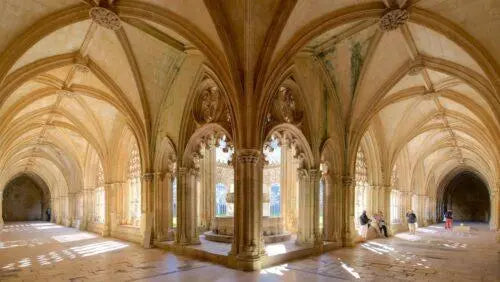CART
Your cart is empty
Let’s find the perfect ...

The site owner may have set restrictions that prevent you from accessing the site. Please contact the site owner for access.

News


Sunset over Nazaré
Nazaré is a small town on Portugal’s fabled Silver Coast, known for its beautiful beaches and rustic seaside villages. Tourists flock to this area in summer for sunshine, fresh seafood and regional wines. Winter, however, draws a different crowd. Nazaré is home to some of the biggest waves in the world, and winter is peak season for big-wave surfing. In November I had the uniquely thrilling experience of visiting Nazaré for the Tudor Nazaré Tow Surfing Challenge. Surfers from all over the world converge on Nazaré to surf waves as tall as 80 feet high. This is truly a team sport, with each surfer being towed carefully into position by a partner on a jet ski.

Competition entrance, Nazaré
Why does Nazaré have such gigantic waves? Just offshore an enormous underwater canyon, over 3 miles deep, funnels the huge swells of the Atlantic towards the beach; once they hit the continental shelf, they’re propelled upwards. With such unique geology it’s common for Nazaré to have 30 to 60-foot waves in winter. This is where world records are set! The current record is held by Brazilian surfer Rodrigo Koxa; according to the World Surf League he successfully surfed a wave over 80 foot high at Nazaré’s Praia del Norte beach in 2017.
While I didn’t see a record being set during my trip, it was incredible to watch the action up close. The 2021 competition’s Best Performance winners were Lucas Chianca of Brazil for the men, and Justine Dupont of France for the women. Check out this video to see highlights of the competition:
The main draw at Nazaré is the sea, which offers a perfect half-moon sandy beach. The long promenade is covered in the scrolling patterns of traditional Portuguese stonework. Restaurants, shops and cafés fill the historic buildings, and in summer the shore is lined with colorful awnings.

Winter dusk on the promenade
The fishermen work out of a nearby harbor these days, but in the past they dragged their nets ashore here. Fisherwomen traditionally dry and sell the catch, salting the fish and calamari and leaving it on racks to dry in the sun. Some still wear the historic attire: seven layers of colorful skirts and a wool shawl. The story is that women would pull the extra skirts up and wrap themselves to keep warm while waiting for the boats to return. The layers of colorful Nazaré skirts have a look that fans of Bohemian style will love.

Source: Folk Costume Blog
You’ll find authentic Portuguese culture in full swing at the Nazaré town market. This is the spot to buy fresh local seafood and Portuguese specialties like tinned sardines and olive oil soap. While I love experiencing new restaurants when I travel, visiting the market to pick up locally-made products and do some cooking is a great way to dive into the culture of a place.
Portuguese products and fresh clams from Nazaré market
Nazaré has no major museums or large castles, but there is plenty here for a slow-paced escape. Downtown, visit Bastião Fernandes Square to see the huge Jurassic-period petrified tree that replaced the medieval pillory post. Wander the narrow streets to admire the mosaic pavement and the shabby-chic charm of the architecture; then duck into a bar for a glass of local Torre Vedra wine.

Theatre Chaby Pinheiro, circa 1926
The upper part of Nazaré, known as Sítio, sits on a rock bluff and offers one of the best views in Portugal. If you want some serious exercise it’s a steep 318 meter climb to the top – or you can take the antique funicular.

Sítio and the promenade
I promise the effort is worth it! The view from the top is spectacular:

The view from Sítio
In Sítio you can visit the tiny 14th-century chapel of Our Lady of Nazaré that gives the town its name. According to tradition, a rare Black Madonna statue was carved by St. Joseph and later painted by St. Luke. It was brought to Spain from Nazaréth in the 5th century and hidden for centuries in a cave at the top of Sítio. Today this unusual statue is kept in the nearby Church of Our Lady Of Nazaré.

Our Lady of Nazaré
The little chapel is decorated inside and out with 17th-century azulejos, traditional Portuguese tiles in vivid blue and white. Tile scenes tell the story of a local miracle; the Virgin Mary is said to have stopped a nobleman from riding his horse over the cliff on a foggy day back in 1182. You can even see the imprint of the horse’s hooves in the rock ;)

Azulejos in the chapel
Of course, if you come for the waves be sure to visit Forte de São Miguel Arcanjo. Built in the 16th century to protect the locals from pirates, it later became a lighthouse. This is one of the best spots in town to get close to the big waves. You can also learn more about the waves and the sea at the Nazaré Canyon Interpretation Center inside the fort.

Forte de São Miguel Arcanjo was headquarters for the surf competition
Nazaré is conveniently close to the rich history and architecture of Portugal’s Silver Coast region. Explore the nearby city of Leiria with its impressive castle and cobblestoned streets lined with quaint shops and fantastic local restaurants. Visit Batalha Monastery, one of the most spectacular examples of Gothic architecture in Portugal and a UNESCO World Heritage Site.

The cloister at Batalha Monastery
Take a side trip to Casa-Estúdio Carlos Relvas, a meticulously restored photography studio from the 1800s. The iron and glass studio is both a fascinating photography museum and a spectacular historic building.

Casa-Estúdio Carlos Relvas, Golegã
About twenty minutes away, the Alcobaça Monastery is known for its Baroque architecture and is a UNESCO World Heritage Site. Hike up the hill from the monastery to the Castelo de Alcobaça, a Moorish ruin with spectacular views. Cistercian monks planted the vines on these slopes in the 12th century and founded the local wine industry.
After visiting the Monastery of Alcobaça stop at the nearby village of Cós to see the coffered ceilings, 16th century azulejos and rich gilded altarpiece at the monastery of Santa Maria De Cós.
The best part of an Alcobaça side trip is probably the Museu do Vinho de Alcobaça, which chronicles the history of winemaking in Portugal. Tour the cellars and distillery museum and finish the afternoon with a tasting session before heading back to Nazaré for a seafood dinner.

Dinner in Nazaré
Lisboa, the region around Nazaré, is the heart of Portuguese wine production. Traditional wines are sold in 1.5 or 3-liter flagons known locally as ‘Garrafoes’. A trip to Lisboa to experience the wine culture is a must for any true wine lover. Here you’ll find local wines known for their unique flavors:
Wineries abound in this area, so there are plenty of opportunities for tasting and testing local food and wine combinations. My friends and I enjoyed visiting these two:
The Vale De Cortem Vinhos Biologicos is a small winery that produces high-quality organic wines. They combine both international and Portuguese grape varieties. The cellar at this winery is a romantic setting for wine tasting and serves delicious, authentic local cuisine.
Quinta de Almeira winery is a family-run winery in Torres Vedras. This beautiful vineyard is dedicated to producing the highest quality Portuguese wines. They offer a fantastic wine tasting paired with a traditional Lisbon menu.
Nazaré also has plenty of small, family-owned restaurants where you can sample local dishes like grilled fish and shrimp, calamari, or Bacalhau a Bras – shredded Bacalhau cod fish with onions, scrambled eggs and fried potatoes. In winter, try a rustic soup like Acorda de Marisco. A seafood and bread soup, it began as a poor man’s dish but has become part of a rich food tradition. Grilled sardines are a classic Nazaré dish too, served simply on a bed of salad greens with salted potatoes.

Sardines, Nazaré style
Find a restaurant with a terrace, and you’ll enjoy one of Portugal’s spectacular sunset views while you dine.

Sunset at Nazaré
Nazaré may not be at the top of your travel list, but perhaps it should be. It’s the perfect place to drop out and relax for a few days, soaking up the sun and sea. It’s also a great place to set up camp and explore Portugal’s stunning Silver Coast.
Ciao, Jonathan